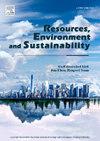Co-control of multi-pollutants and CO2 based on extended life cycle assessment in electrolytic manganese industry
IF 12.4
Q1 ENVIRONMENTAL SCIENCES
引用次数: 0
Abstract
The electrolytic manganese metal (EMM) industry has long been restricted because of associated heavy pollution and high CO2 emissions. In this study, an extended life cycle assessment (LCA) was conducted on the entire process of EMM production and an integrative decision-making framework was developed for the co-abatement of multiple pollutants and CO2, including emissions accounting, program design, and co-abatement economic benefits assessment. In the extended LCA that additionally considers the electric power supply and manganese residue treatment, the CO2 emissions from EMM production increased by 173% and the equivalent pollutant loads decreased by 85%. A technical guideline consisting of 16 co-control measures was formulated based on capacity adjustment, energy structure optimization, production management, and technical equipment upgrading. After eliminating the overlapping abatement effects among measures, this scheme achieved a cumulative abatement potential of 35.3% for CO2 and 96.3% for the equivalent pollutants. The co-econ ranking results show that technologies based on the concepts of source reduction and resource recycling are more environmentally friendly and cost-efficient. Sensitivity analysis proved that the results were robust. This study enriches the theory of co-control of emissions and provides an efficient and credible methodology and practical reference for policymakers and industrial enterprises.

基于延长生命周期评价的电解锰工业多污染物与CO2协同控制
电解金属锰(EMM)行业长期以来因污染严重和二氧化碳排放高而受到限制。本研究对EMM生产全过程进行了延长生命周期评价(LCA),构建了多种污染物与CO2协同减排的综合决策框架,包括排放核算、方案设计和协同减排经济效益评价。在考虑电力供应和锰渣处理的扩展LCA中,EMM生产的CO2排放量增加了173%,等效污染物负荷减少了85%。制定了产能调整、能源结构优化、生产管理和技术装备改造等16项协同控制措施的技术指导意见。在消除措施间的重叠减排效应后,该方案对CO2的累计减排潜力为35.3%,对当量污染物的累计减排潜力为96.3%。协同经济排名结果表明,基于源减量和资源循环理念的技术更环保,成本效益更高。敏感性分析证明了结果的稳健性。本研究丰富了排放协同控制理论,为政策制定者和工业企业提供了高效可信的方法和实践参考。
本文章由计算机程序翻译,如有差异,请以英文原文为准。
求助全文
约1分钟内获得全文
求助全文
来源期刊

Resources Environment and Sustainability
Environmental Science-Environmental Science (miscellaneous)
CiteScore
15.10
自引率
0.00%
发文量
41
审稿时长
33 days
 求助内容:
求助内容: 应助结果提醒方式:
应助结果提醒方式:


